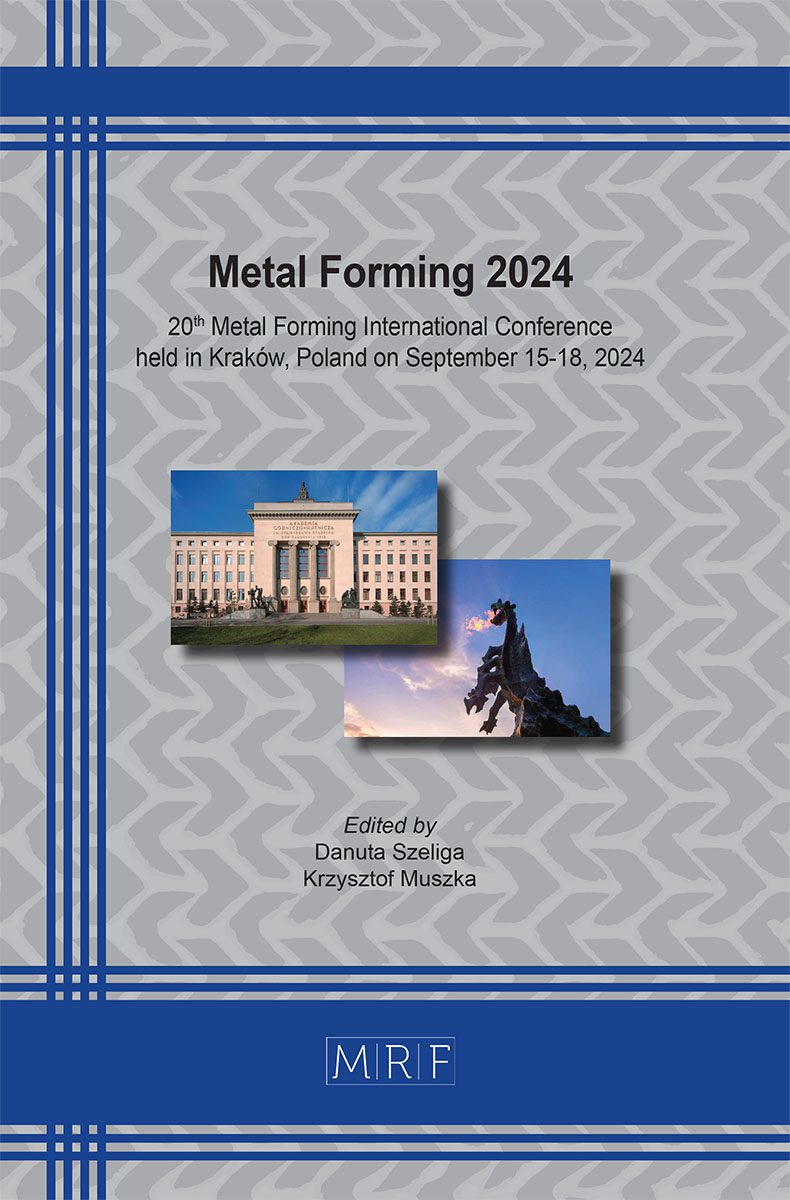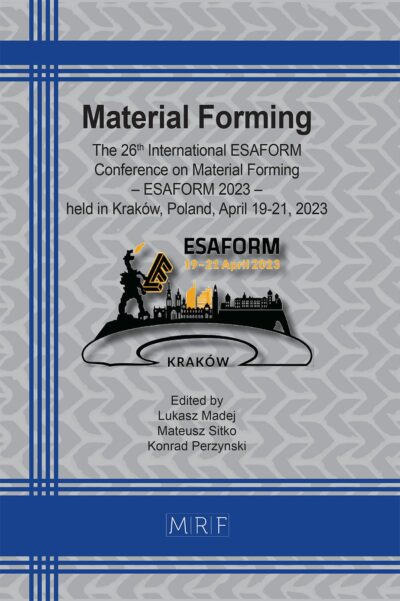–
Forming of lightweight helical gears by means of sheet-bulk metal forming
RECK Manuel, MERKLEIN Marion
download PDFAbstract. A rising demand on resource efficient and highly functional products causes conventional metal forming processes to the reach their limits. For this reason, sheet-bulk metal forming (SBMF) for the production of thin-walled components with various filigree functional elements has been widely investigated in recent years. However, there is a research gap in the understanding of approaches within this process class for producing helical gears. These are in high demand in industrial environments due to their smooth running capabilities. In this study, a process combination of deep drawing and lateral extrusion for the production of helical lightweight gears is therefore examined. In the reference variant, the mild deep-drawing steel DC04 with a sheet thickness of t0 = 2.0 mm is formed with a 20° helical die. General process limits are derived depending on the die filling of the tool-side cavities. In addition, the influence of the gear angle on process and component target variables is analyzed and discussed.
Keywords
Gear, Sheet Metal, Extrusion, Cold Forming
Published online 9/15/2024, 10 pages
Copyright © 2024 by the author(s)
Published under license by Materials Research Forum LLC., Millersville PA, USA
Citation: RECK Manuel, MERKLEIN Marion, Forming of lightweight helical gears by means of sheet-bulk metal forming, Materials Research Proceedings, Vol. 44, pp 113-122, 2024
DOI: https://doi.org/10.21741/9781644903254-13
The article was published as article 13 of the book Metal Forming 2024
![]() Content from this work may be used under the terms of the Creative Commons Attribution 3.0 license. Any further distribution of this work must maintain attribution to the author(s) and the title of the work, journal citation and DOI.
Content from this work may be used under the terms of the Creative Commons Attribution 3.0 license. Any further distribution of this work must maintain attribution to the author(s) and the title of the work, journal citation and DOI.
References
[1] World Population Prospects 2022: Summary of Results. (2022).
[2] R. Stark, G. Seliger, J. Bonvoisin, Sustainable Manufacturing, Cham: Springer, (2017).
[3] Wyman, O.: Massiver Wandel in der automobilen Wertschöpfungsstruktur. (2012).
[4] M. Kleiner, M. Geiger, A. Klaus, Manufacturing of Lightweight Components by Metal Forming, CIRP Annals 52 (2003) 521-542. https://doi.org/10.1016/S0007-8506(07)60202-9
[5] D.V. Pelegov, J.-J. Chanaron, Electric Car Market Analysis Using Open Data: Sales, Volatility Assessment, and Forecasting, Sustainability 15 (2022) 1. https://doi.org/10.3390/su15010399
[6] B. Klein, T. Gänsicke, Leichtbau-Konstruktion: Springer, (2019).
[7] R. Golloch, Downsizing bei Verbrennungsmotoren: Springer, (2005).
[8] T. Biermann, T. Smetana, Schaeffler lightweight differentials. Schaeffler Symposium, (2010).
[9] M. Merklein, J.M. Allwood, B.A. Behrens, A. Brosius, H. Hagenah, K. Kuzman, K. Mori, A.E. Tekkaya, A. Weckenmann, Bulk forming of sheet metal, CIRP Annals, 61 (2012) 725-745. https://doi.org/10.1016/j.cirp.2012.05.007
[10] F. Pilz, M. Merklein, Comparison of extrusion processes in sheet-bulk metal forming for production of filigree functional elements, CIRP J. Manuf. Sci. Tech. 26 (2019) 41-49. https://doi.org/10.1016/j.cirpj.2019.05.004
[11] H. Zein, O.M. Irfan, Optimization and Mapping of the Deep Drawing Force Considering Friction Combination, Applied Sci. 11 (2021) 19. https://doi.org/10.3390/app11199235
[12] F. Pilz, D. Gröbel, M. Merklein, Investigation of fatigue strength of tool steels in sheet-bulk metal forming: AIP Conference Proceedings, 2018.
[13] T. Trzepieciński, Approaches for Preventing Tool Wear in Sheet Metal Forming Processes, Machines 11 (2023) 6. https://doi.org/10.3390/machines11060616
[14] A. Nilsson, L. Kirkhorn, M. Andersson, J.E. Ståhl, Improved tool wear properties in sheet metal forming using Carbide Steel, a novel abrasion resistant cast material, Wear 271 (2011) 1280-1287. https://doi.org/10.1016/j.wear.2011.01.083
[15] C. Kiener, Kaltfließpressen von gerad- und schrägverzahnten Zahnrädern. Dissertation, Friedrich-Alexander-Universität Erlangen-Nürnberg, 2020.
[16] J. Lai, J. Liu, H. Hu, J. Yu, A. Zhang, W. Yuan, Z. Gao, Contribution of hardness and work hardening to the wear resistance of Pt-based metallic surfaces revealed by nanoscale reciprocating sliding, Applied Surf. Sci. 614 (2023) 156178. https://doi.org/10.1016/j.apsusc.2022.156178














